roof PONTIAC VIBE 2007 Owners Manual
[x] Cancel search | Manufacturer: PONTIAC, Model Year: 2007, Model line: VIBE, Model: PONTIAC VIBE 2007Pages: 432, PDF Size: 2.54 MB
Page 1 of 432
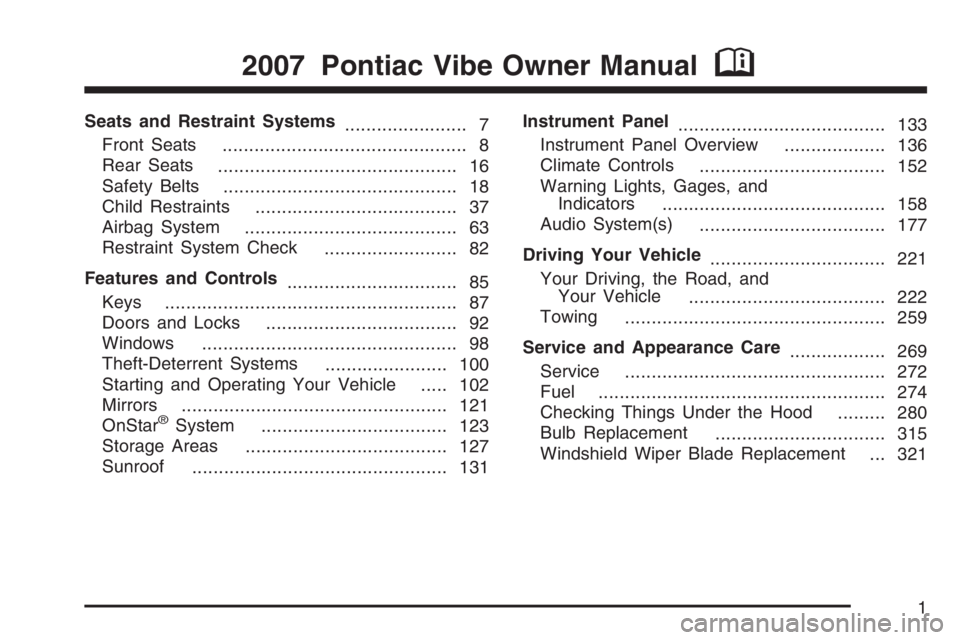
Seats and Restraint Systems
....................... 7
Front Seats
.............................................. 8
Rear Seats
............................................. 16
Safety Belts
............................................ 18
Child Restraints
...................................... 37
Airbag System
........................................ 63
Restraint System Check
......................... 82
Features and Controls
................................ 85
Keys
....................................................... 87
Doors and Locks
.................................... 92
Windows
................................................ 98
Theft-Deterrent Systems
....................... 100
Starting and Operating Your Vehicle
..... 102
Mirrors
.................................................. 121
OnStar
®System
................................... 123
Storage Areas
...................................... 127
Sunroof
................................................ 131Instrument Panel
....................................... 133
Instrument Panel Overview
................... 136
Climate Controls
................................... 152
Warning Lights, Gages, and
Indicators
.......................................... 158
Audio System(s)
................................... 177
Driving Your Vehicle
................................. 221
Your Driving, the Road, and
Your Vehicle
..................................... 222
Towing
................................................. 259
Service and Appearance Care
.................. 269
Service
................................................. 272
Fuel
...................................................... 274
Checking Things Under the Hood
......... 280
Bulb Replacement
................................ 315
Windshield Wiper Blade Replacement
... 321
2007 Pontiac Vibe Owner ManualM
1
Page 63 of 432
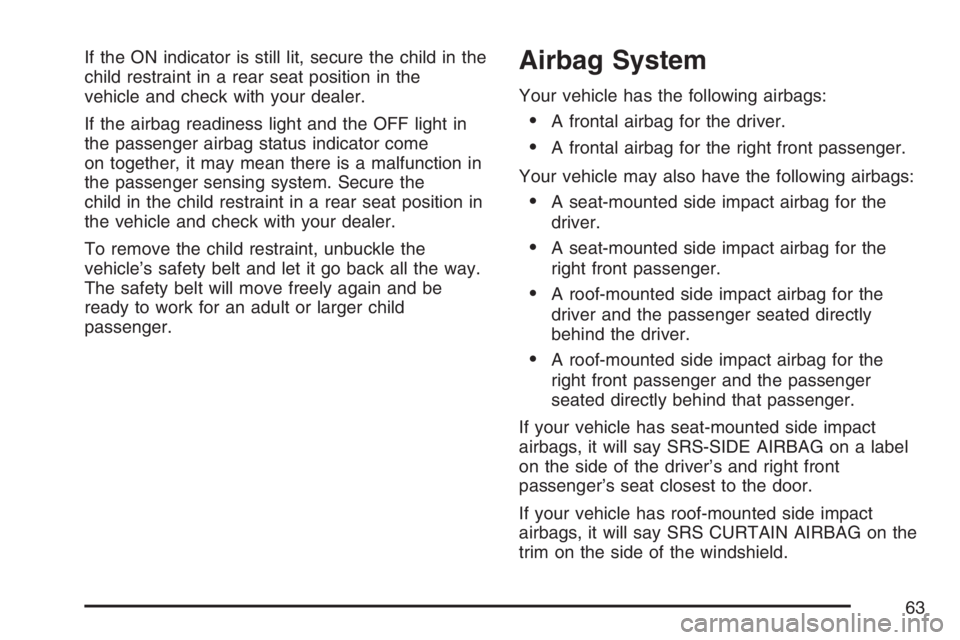
If the ON indicator is still lit, secure the child in the
child restraint in a rear seat position in the
vehicle and check with your dealer.
If the airbag readiness light and the OFF light in
the passenger airbag status indicator come
on together, it may mean there is a malfunction in
the passenger sensing system. Secure the
child in the child restraint in a rear seat position in
the vehicle and check with your dealer.
To remove the child restraint, unbuckle the
vehicle’s safety belt and let it go back all the way.
The safety belt will move freely again and be
ready to work for an adult or larger child
passenger.Airbag System
Your vehicle has the following airbags:
A frontal airbag for the driver.
A frontal airbag for the right front passenger.
Your vehicle may also have the following airbags:
A seat-mounted side impact airbag for the
driver.
A seat-mounted side impact airbag for the
right front passenger.
A roof-mounted side impact airbag for the
driver and the passenger seated directly
behind the driver.
A roof-mounted side impact airbag for the
right front passenger and the passenger
seated directly behind that passenger.
If your vehicle has seat-mounted side impact
airbags, it will say SRS-SIDE AIRBAG on a label
on the side of the driver’s and right front
passenger’s seat closest to the door.
If your vehicle has roof-mounted side impact
airbags, it will say SRS CURTAIN AIRBAG on the
trim on the side of the windshield.
63
Page 68 of 432
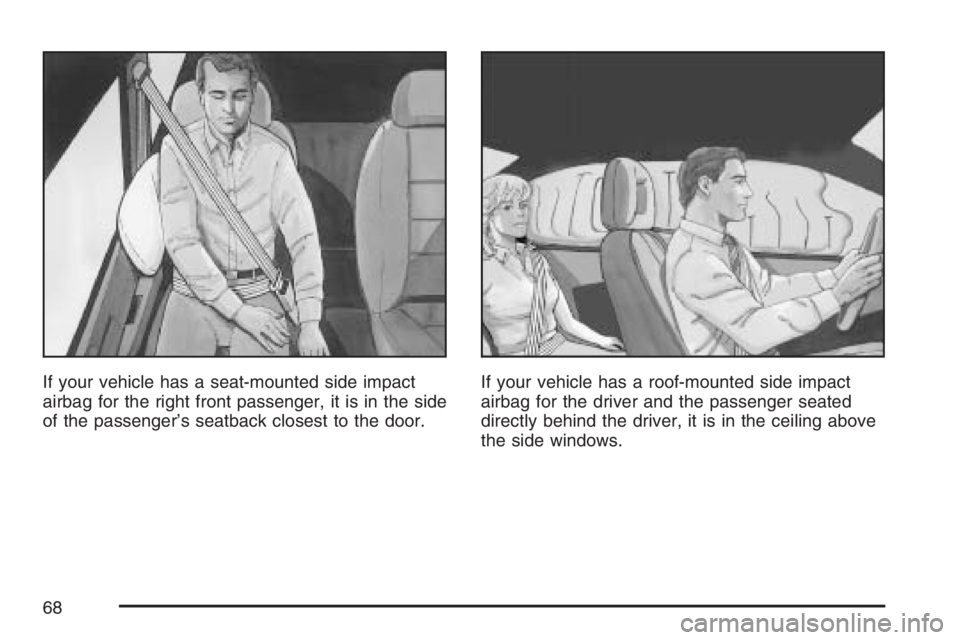
If your vehicle has a seat-mounted side impact
airbag for the right front passenger, it is in the side
of the passenger’s seatback closest to the door.If your vehicle has a roof-mounted side impact
airbag for the driver and the passenger seated
directly behind the driver, it is in the ceiling above
the side windows.
68
Page 69 of 432
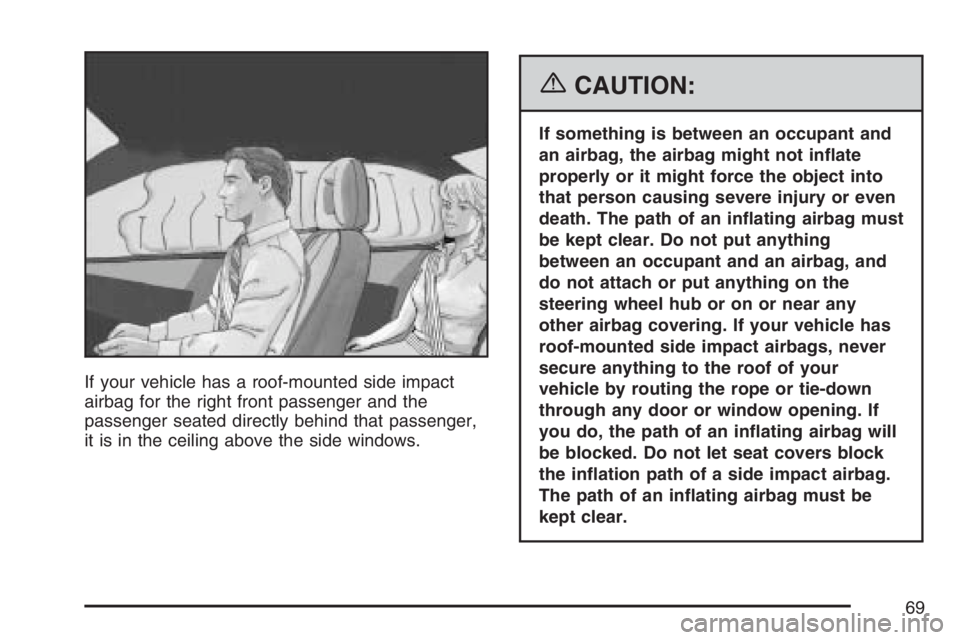
If your vehicle has a roof-mounted side impact
airbag for the right front passenger and the
passenger seated directly behind that passenger,
it is in the ceiling above the side windows.
{CAUTION:
If something is between an occupant and
an airbag, the airbag might not in�ate
properly or it might force the object into
that person causing severe injury or even
death. The path of an in�ating airbag must
be kept clear. Do not put anything
between an occupant and an airbag, and
do not attach or put anything on the
steering wheel hub or on or near any
other airbag covering. If your vehicle has
roof-mounted side impact airbags, never
secure anything to the roof of your
vehicle by routing the rope or tie-down
through any door or window opening. If
you do, the path of an in�ating airbag will
be blocked. Do not let seat covers block
the in�ation path of a side impact airbag.
The path of an in�ating airbag must be
kept clear.
69
Page 71 of 432
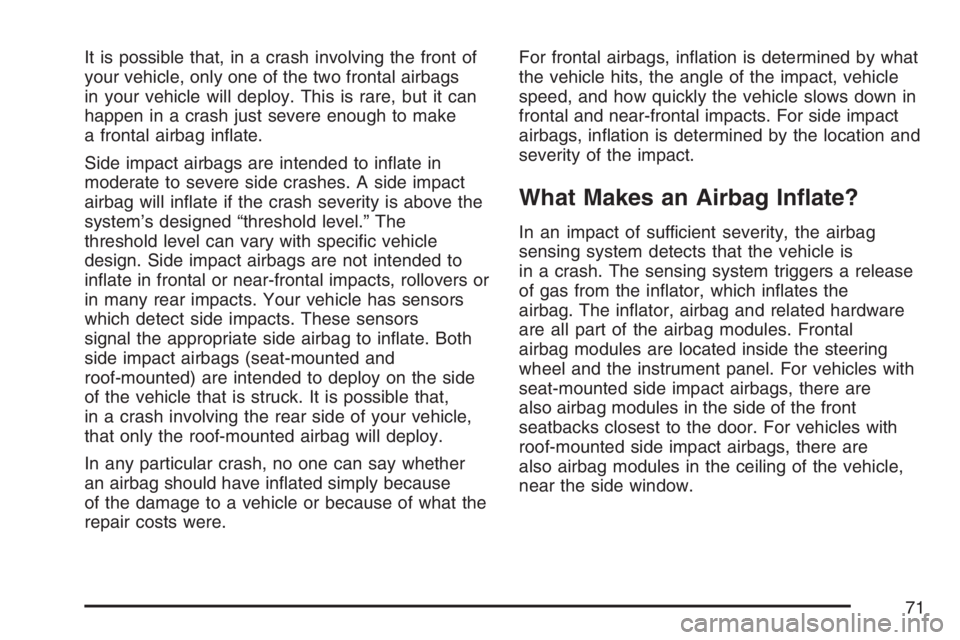
It is possible that, in a crash involving the front of
your vehicle, only one of the two frontal airbags
in your vehicle will deploy. This is rare, but it can
happen in a crash just severe enough to make
a frontal airbag in�ate.
Side impact airbags are intended to in�ate in
moderate to severe side crashes. A side impact
airbag will in�ate if the crash severity is above the
system’s designed “threshold level.” The
threshold level can vary with speci�c vehicle
design. Side impact airbags are not intended to
in�ate in frontal or near-frontal impacts, rollovers or
in many rear impacts. Your vehicle has sensors
which detect side impacts. These sensors
signal the appropriate side airbag to in�ate. Both
side impact airbags (seat-mounted and
roof-mounted) are intended to deploy on the side
of the vehicle that is struck. It is possible that,
in a crash involving the rear side of your vehicle,
that only the roof-mounted airbag will deploy.
In any particular crash, no one can say whether
an airbag should have in�ated simply because
of the damage to a vehicle or because of what the
repair costs were.For frontal airbags, in�ation is determined by what
the vehicle hits, the angle of the impact, vehicle
speed, and how quickly the vehicle slows down in
frontal and near-frontal impacts. For side impact
airbags, in�ation is determined by the location and
severity of the impact.
What Makes an Airbag In�ate?
In an impact of sufficient severity, the airbag
sensing system detects that the vehicle is
in a crash. The sensing system triggers a release
of gas from the in�ator, which in�ates the
airbag. The in�ator, airbag and related hardware
are all part of the airbag modules. Frontal
airbag modules are located inside the steering
wheel and the instrument panel. For vehicles with
seat-mounted side impact airbags, there are
also airbag modules in the side of the front
seatbacks closest to the door. For vehicles with
roof-mounted side impact airbags, there are
also airbag modules in the ceiling of the vehicle,
near the side window.
71
Page 72 of 432
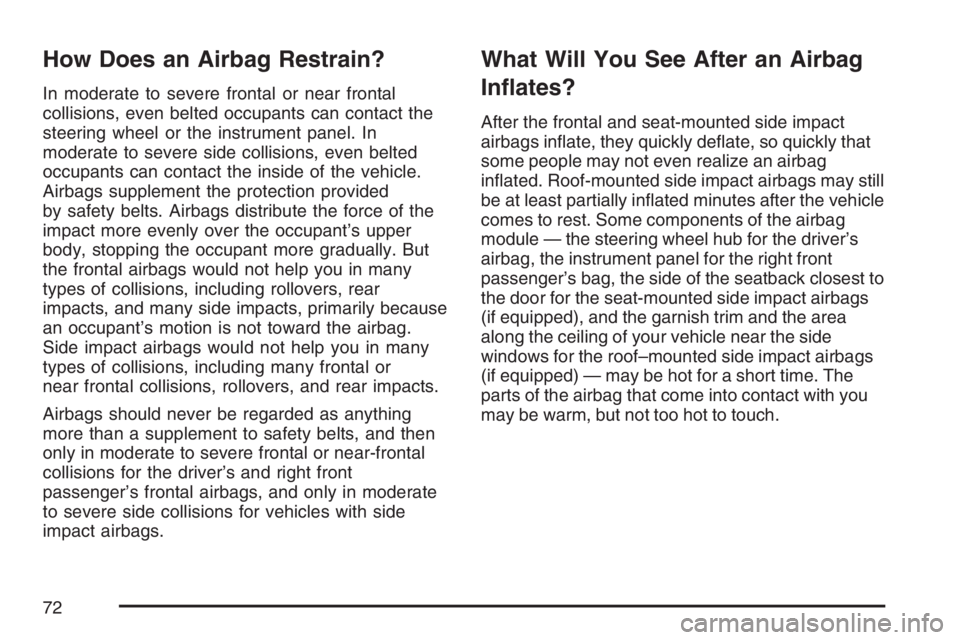
How Does an Airbag Restrain?
In moderate to severe frontal or near frontal
collisions, even belted occupants can contact the
steering wheel or the instrument panel. In
moderate to severe side collisions, even belted
occupants can contact the inside of the vehicle.
Airbags supplement the protection provided
by safety belts. Airbags distribute the force of the
impact more evenly over the occupant’s upper
body, stopping the occupant more gradually. But
the frontal airbags would not help you in many
types of collisions, including rollovers, rear
impacts, and many side impacts, primarily because
an occupant’s motion is not toward the airbag.
Side impact airbags would not help you in many
types of collisions, including many frontal or
near frontal collisions, rollovers, and rear impacts.
Airbags should never be regarded as anything
more than a supplement to safety belts, and then
only in moderate to severe frontal or near-frontal
collisions for the driver’s and right front
passenger’s frontal airbags, and only in moderate
to severe side collisions for vehicles with side
impact airbags.
What Will You See After an Airbag
In�ates?
After the frontal and seat-mounted side impact
airbags in�ate, they quickly de�ate, so quickly that
some people may not even realize an airbag
in�ated. Roof-mounted side impact airbags may still
be at least partially in�ated minutes after the vehicle
comes to rest. Some components of the airbag
module — the steering wheel hub for the driver’s
airbag, the instrument panel for the right front
passenger’s bag, the side of the seatback closest to
the door for the seat-mounted side impact airbags
(if equipped), and the garnish trim and the area
along the ceiling of your vehicle near the side
windows for the roof–mounted side impact airbags
(if equipped) — may be hot for a short time. The
parts of the airbag that come into contact with you
may be warm, but not too hot to touch.
72
Page 81 of 432
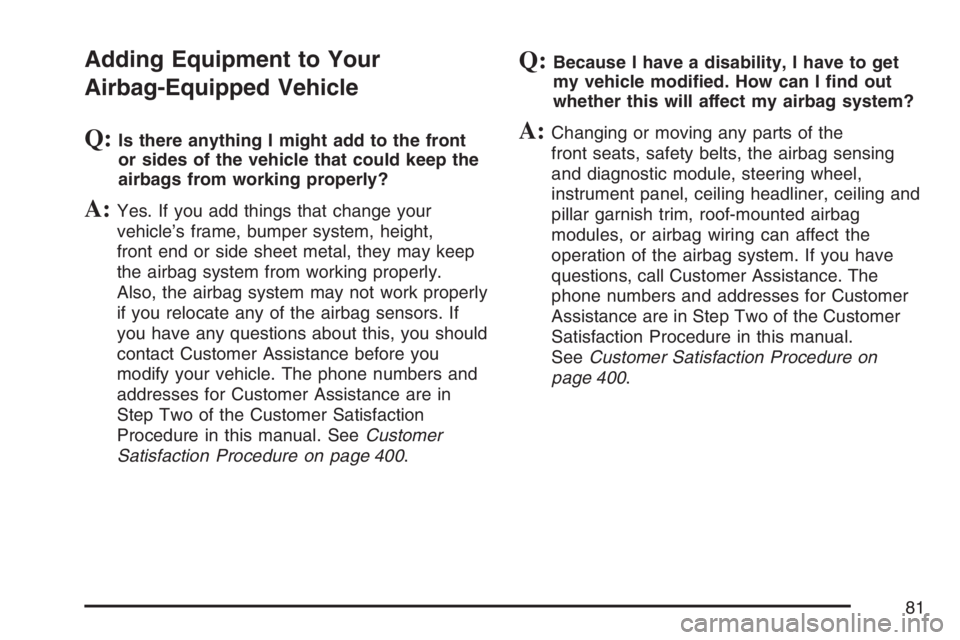
Adding Equipment to Your
Airbag-Equipped Vehicle
Q:Is there anything I might add to the front
or sides of the vehicle that could keep the
airbags from working properly?
A:Yes. If you add things that change your
vehicle’s frame, bumper system, height,
front end or side sheet metal, they may keep
the airbag system from working properly.
Also, the airbag system may not work properly
if you relocate any of the airbag sensors. If
you have any questions about this, you should
contact Customer Assistance before you
modify your vehicle. The phone numbers and
addresses for Customer Assistance are in
Step Two of the Customer Satisfaction
Procedure in this manual. SeeCustomer
Satisfaction Procedure on page 400.
Q:Because I have a disability, I have to get
my vehicle modi�ed. How can I �nd out
whether this will affect my airbag system?
A:Changing or moving any parts of the
front seats, safety belts, the airbag sensing
and diagnostic module, steering wheel,
instrument panel, ceiling headliner, ceiling and
pillar garnish trim, roof-mounted airbag
modules, or airbag wiring can affect the
operation of the airbag system. If you have
questions, call Customer Assistance. The
phone numbers and addresses for Customer
Assistance are in Step Two of the Customer
Satisfaction Procedure in this manual.
SeeCustomer Satisfaction Procedure on
page 400.
81
Page 82 of 432
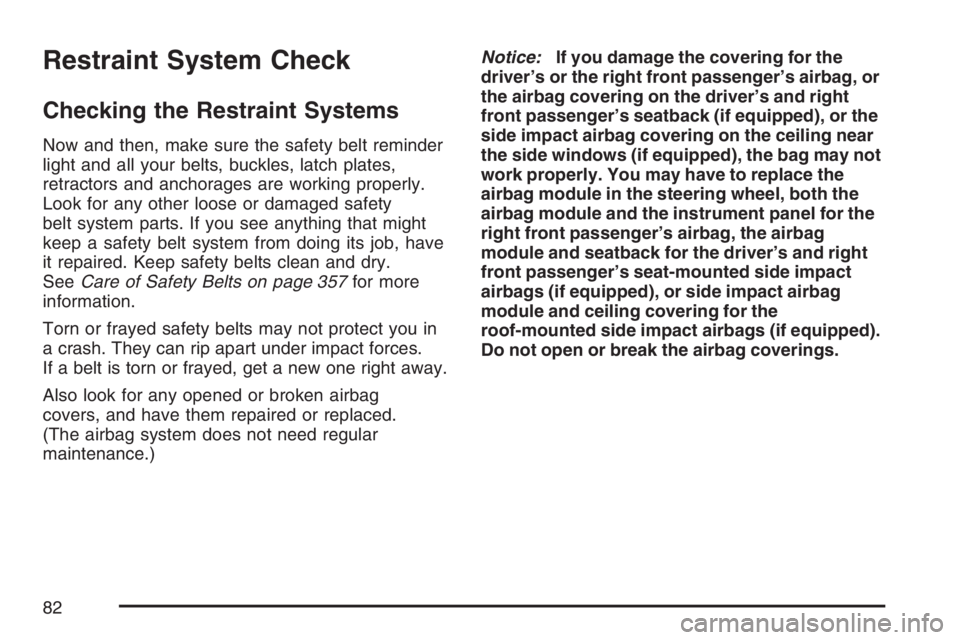
Restraint System Check
Checking the Restraint Systems
Now and then, make sure the safety belt reminder
light and all your belts, buckles, latch plates,
retractors and anchorages are working properly.
Look for any other loose or damaged safety
belt system parts. If you see anything that might
keep a safety belt system from doing its job, have
it repaired. Keep safety belts clean and dry.
SeeCare of Safety Belts on page 357for more
information.
Torn or frayed safety belts may not protect you in
a crash. They can rip apart under impact forces.
If a belt is torn or frayed, get a new one right away.
Also look for any opened or broken airbag
covers, and have them repaired or replaced.
(The airbag system does not need regular
maintenance.)Notice:If you damage the covering for the
driver’s or the right front passenger’s airbag, or
the airbag covering on the driver’s and right
front passenger’s seatback (if equipped), or the
side impact airbag covering on the ceiling near
the side windows (if equipped), the bag may not
work properly. You may have to replace the
airbag module in the steering wheel, both the
airbag module and the instrument panel for the
right front passenger’s airbag, the airbag
module and seatback for the driver’s and right
front passenger’s seat-mounted side impact
airbags (if equipped), or side impact airbag
module and ceiling covering for the
roof-mounted side impact airbags (if equipped).
Do not open or break the airbag coverings.
82
Page 86 of 432
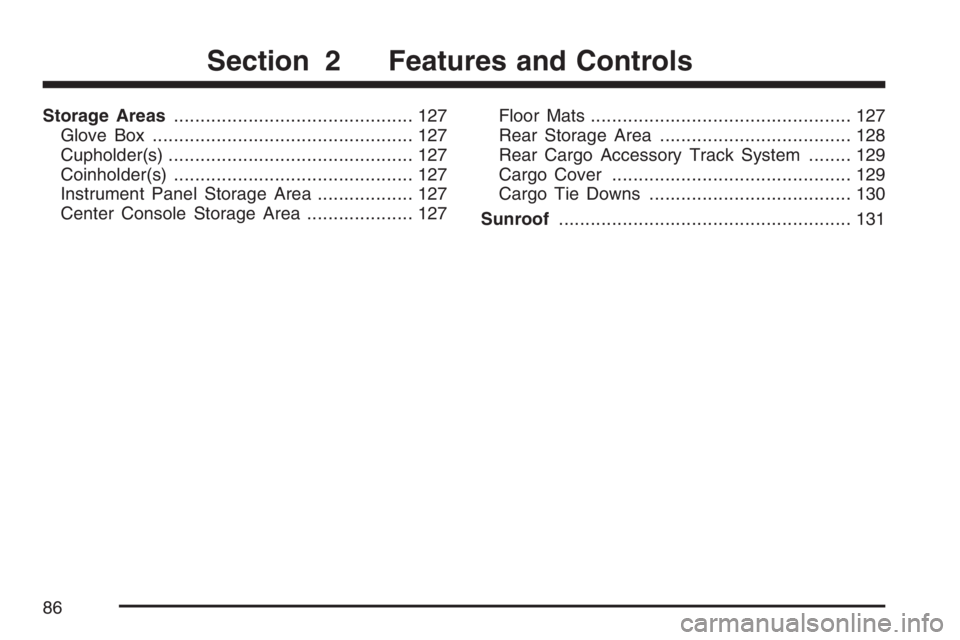
Storage Areas............................................. 127
Glove Box................................................. 127
Cupholder(s).............................................. 127
Coinholder(s)............................................. 127
Instrument Panel Storage Area.................. 127
Center Console Storage Area.................... 127Floor Mats................................................. 127
Rear Storage Area.................................... 128
Rear Cargo Accessory Track System........ 129
Cargo Cover............................................. 129
Cargo Tie Downs...................................... 130
Sunroof....................................................... 131
Section 2 Features and Controls
86
Page 99 of 432
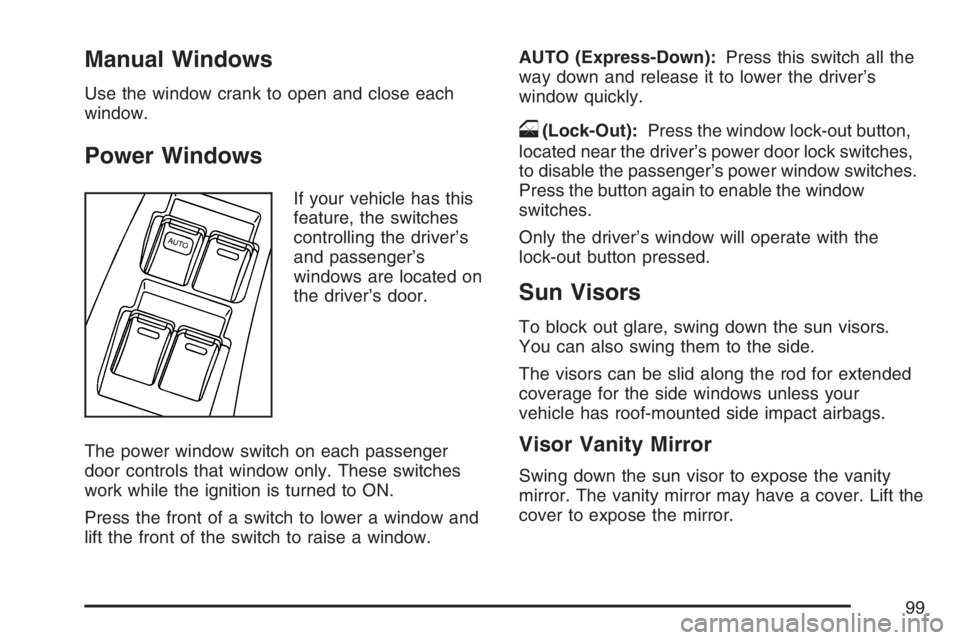
Manual Windows
Use the window crank to open and close each
window.
Power Windows
If your vehicle has this
feature, the switches
controlling the driver’s
and passenger’s
windows are located on
the driver’s door.
The power window switch on each passenger
door controls that window only. These switches
work while the ignition is turned to ON.
Press the front of a switch to lower a window and
lift the front of the switch to raise a window.AUTO (Express-Down):Press this switch all the
way down and release it to lower the driver’s
window quickly.
o(Lock-Out):Press the window lock-out button,
located near the driver’s power door lock switches,
to disable the passenger’s power window switches.
Press the button again to enable the window
switches.
Only the driver’s window will operate with the
lock-out button pressed.
Sun Visors
To block out glare, swing down the sun visors.
You can also swing them to the side.
The visors can be slid along the rod for extended
coverage for the side windows unless your
vehicle has roof-mounted side impact airbags.
Visor Vanity Mirror
Swing down the sun visor to expose the vanity
mirror. The vanity mirror may have a cover. Lift the
cover to expose the mirror.
99